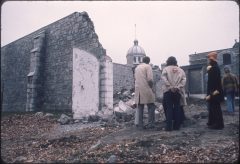PRESERVING HERITAGE: A SUMMER AT THE AVRC

Professor Pierre du Prey and Queen’s University students stand in protest to save the 19th Century Frontenac County Jail in Kingston, Ontario (demolished in 1973).
by Purity Gituma
This summer, I had a unique opportunity to channel my interests in media and heritage preservation while working as a Collections Assistant at the Audio-Visual Resources Centre (AVRC) under the Young Canada Works (YCW) program.
Tasked with the vital role of processing and digitizing the newly acquired du Prey 35mm film slide collection, I found myself immersed in the architectural gems captured through these slides. As a fourth-year student in the History and Theory of Architecture (HTA) program, this was a meaningful and inspiring experience.
At the heart of this collection is Pierre du Prey, Professor Emeritus of Art History at Queen’s University, and architectural historian whose incredible legacy is revealed in each slide.
Comprising over 40,000 meticulously preserved and organized 35mm film slides, the du Prey collection offers a glimpse into the international architectural landscape of the twentieth century.
In fact, these slides hold historical significance in their own right, documenting historic buildings and landscapes that have been transformed, or sadly lost to history.
Thus, the impressive slide collection not only attests to Professor du Prey’s global explorations but embodies his commitment to documenting and preserving the built environment.
With remarkably stable film slides dating back to as early as the 1960s, the extensive collection holds a hoard of incredible histories waiting to be explored.
While engaging with the slides, I was particularly drawn to its documentation of early Heritage Conservation initiatives in Canada.
For instance, the du Prey collection gives rare insight into the evolution of the Frontenac County Jail in Kingston, Ontario, before, during, and after its demolition in 1973.
Showcased here is a striking photograph of Professor du Prey and his students standing united in protest against the demolition of the 118-year-old jail.
This image not only offers a glimpse into the past but also shows Professor du Prey’s dedication to fostering? a deep appreciation for architectural heritage beyond the classroom.
Contemplating on this image, I was transported back to this moment and captivated by their shared spirit of determination to protect the legacy embedded in the historical landmark.
Evidently, the significance of preserving original slide collections like the du Prey collection goes far beyond pure nostalgia.
While digital images are prevalent today, the AVRC’s commitment to preserving the historical value embedded in these physical artifacts ensures that the insights and stories they contain will continue to be accessible for future research opportunities.
I am grateful for the opportunity to explore the du Prey collection and to contribute to its accessibility.
This experience has broadened my understanding of architectural history and helped me appreciate the contributions of individuals like du Prey in preserving heritage.
I am hopeful that the AVRC will continue in its mission of safeguarding these historic audiovisual resources.